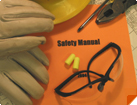Electrical safety
Electrical power use on building sites is particularly hazardous because of the need to use cables and flexible extension cords, and the power is often used in damp conditions.
Precautions must be taken to protect workers from electric shock, electrocution, fires and explosions.
On this page:
- precautions when using power
- safeguards for electrical supply
- temporary supply switchboards
- electrical equipment inspection
- underground and overhead power lines.
Precautions when using power
Precautions when using power on a building site include:
- do not overload circuits
- do not used damaged flexible extension cords
- keep flexible extension cords away from sharp edges
- do not use electrical equipment in wet conditions
- use equipment suitable for the working environment, e.g. cordless tools for damp conditions.
Safeguards for electrical supply
If a portable electrical appliance is used in damp situations, it must have the following safeguards:
- An isolating transformer with a voltage between conductors not exceeding 230 volts.
- A earth circuit that is monitored – if it is broken or disconnected, the power to the appliance will automatically be disconnected.
- Double insulation to the appliance.
- A source to earth connection so that the earth voltage does not exceed 55 volts.
- A residual current device (RCD).
Temporary supply switchboards
Temporary supply switchboards on building sites should:
- be solidly constructed
- be fixed to a permanent or specifically designed structure
- should be weathertight for safe operation where installed outdoors
- include an insulated slot in the bottom for cables and leads to feed through
- provide a stand for the support of cables and flexible extension cords
- have a door that can be locked, will not damage flexible cords and protect switches from mechanical damage.
Electrical equipment inspection
Electrical tools and equipment should:
- be inspected before initial use and at 3 month intervals
- be tagged to identify the previous and next due inspection dates.
Underground and overhead power lines
When carrying out an excavation, always assume that cables will be present. Take precautions against striking underground cables by confirming the location of underground cables (and other services) and obtaining up-to-date electrical plans for adjacent buildings.
If working close to underground or overhead cables:
- have the power temporarily disconnected by the utility company
- do not allow any part of a crane, digger, excavator, drill rig or other mechanical plant, structure or scaffold closer than 4.0 m to an overhead line without the written consent of the power line owner.
FOR PHILIPPINE ELECTRICAL INQUIRIES CONCERNS AND ORDERS:
EMAIL US: SAFEELECTRICAL2013@GMAIL.COM
FOR PHILIPPINE ELECTRICAL INQUIRIES CONCERNS AND ORDERS:
EMAIL US: SAFEELECTRICAL2013@GMAIL.COM


No comments:
Post a Comment